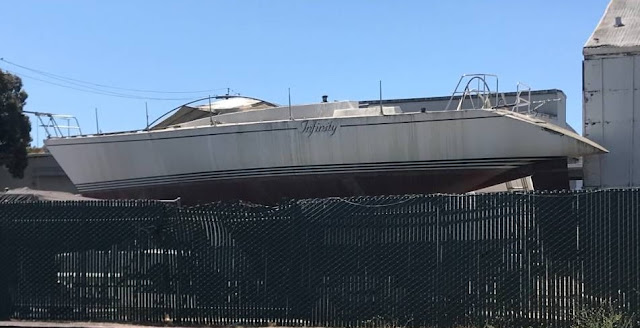 |
| Road Warrior - 1984 Newport-Bermuda Race |
Dazzler had some interesting duels with Diva during the SORC, which was one of the first of the new breed of fractional lighter displacement yachts designed by Joubert/Nivelt. Dazzler was sailed by Bill Shore and Perry Harris, and breezed home in the heavily weighted Lauderdale race ahead of Diva, Allegiance (an Alan Andrews-designed One Tonner) and Alethea. Dazzler held onto her overall lead for two more races until Diva and Allegiance had a memorable first and second in the Miami-Nassau race, separated by just 3 seconds.
 |
| The Main Bear (left) during the 1985 SORC |
Despite their initial success, the J/41's represented the end of the competitive masthead boats at the One Ton level, and after the 1985 season were considered something of an anachronism in the emerging trend towards fractional rigs in top level racing at the time. They were not widely regarded as the fastest boats on the track, but were marketed at the time as being easier to sail than their fractional competition. Consistency was emphasised, with higher average speeds across the wind range considered to compare favourably to the "moments of blinding speed interspersed with unbelievably slows" of their competition.
 |
| Jack Knife (photo One Ton Class Facebook page) |
 |
| The fine ends and slightly bow down trim of the J/41 in IOR mode (photo J Boats) |
 |
| One of the many J/41's, Merrimac (photo J Boats) |
 The J/41's were also noted for their structural integrity, when five survived the rough 1984 Bermuda Race, and two survived the SORC that year without failure. Construction nevertheless pushed the limits of the time, utilising vacuum bagged unidirectional aircraft-grade Baltek Contourkote sandwich and 1/8th inch unidirectional carbon fibre skins for increased rigidity and impact resistance in critical areas.
The J/41's were also noted for their structural integrity, when five survived the rough 1984 Bermuda Race, and two survived the SORC that year without failure. Construction nevertheless pushed the limits of the time, utilising vacuum bagged unidirectional aircraft-grade Baltek Contourkote sandwich and 1/8th inch unidirectional carbon fibre skins for increased rigidity and impact resistance in critical areas. Road Warrior missed the 1984 SORC but raced in the 1985 event as The Main Bear, and was later renamed Lorimar. She is now owned by a Dutch yachtsman Jan Kuffel who bought the boat in 2008 in Long Island and she is now called Red Gull after her sponsor. Red Gull regularly lines up in IOR regattas hosted in the Netherlands against other older boats such as 45 South II, Canterbury, Container, Caiman, Jamarella, Lady Be, Morningstar, Marionette, Pinta and the like.
 |
| The happy crew of Red Gull, now sailing in Europe (photo Jan Kuffel) |





















